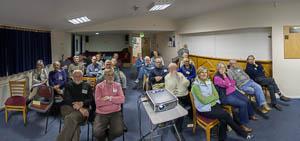
Tonight, Martin Tomes, our resident 'Techno" gave us a very interesting and informative talk on HDR images and Panoramas.
We were very honoured with the presence of two old friends of the club, firstly Cliff Carter from Steyning CC, (himself a great expert on panoramas, Photoshop and Mac computers) and secondly by Susan Worsfold, who when she joined SCC some years ago was by far our youngest member, she has now moved away to Southwater. We also had another visitor, David, who had seen an item on our club somewhere in a publication which mentioned tonight's talk, thus proving that the work of our new publicity lady Glen Donnelly is bearing fruit.
Martin kicked off the evening by giving us a quick run down on some technical data about the various abilities of our eyes and film and digital cameras to cope with dynamic range. Luckily for me Martin always edits my reports before they are published so he can correct anything that I have got wrong, me being a dedicated non technical old fart with alzheimers fast setting in!!
Also it is worth mentioning that several of our new members asked some very intelligent questions which were quite beyond the scope of the knowledge of most of the rest of us, which is very reassuring.
The first half was devoted to HDR photography which is becoming very popular as we see with entries in county competitions from other clubs. It is usually very dramatic but needs to be done with skill or the images can look totally unreal and unappealing. Basically, this technique allows you to have an image, lets say of a landscape, with all the detail in the very light bits, e.g. the sky, together with detail in the very dark shadows which your average camera cannot record in one image. So, you take at least three images, exposing firstly for the sky (when the rest of the image is very dark), secondly, a normal shot which takes care of most of the image, and lastly a shot exposing for the detail in the very dark parts when the sky is probably completely overexposed and totally lacks detail. Typically there would be two stops difference between each frame. Most modern SLRs can be set to take three 'bracketed' shots which will do this, all the better if done on a tripod, so all the images exactly fit on top of each other. These can be then loaded into different programmes which will do their magic and select the right bits of each exposure to combine to give you an image with detail throughout. Martin mentioned a programme called Photomatix which is very good at tonemapping an HDRI image. Adobe Photoshop CS6 has an HDR tool and other photoshop versions may also. Another way of achieving the same result, but with more processing to do, is to take a RAW image and then in your editing programme alter the exposure three different times with say 2 stops difference between them and save the results separately, and then put them into layers and bring out the detail that you want from each layer where you want it. We were shown several different images which Martin had created in HDR and he told us how he had got the finished picture.
The second half was devoted to creating panoramas. He did one on his phone, the latest ones do the stiching of the images as you sweep the camera, amazing. However, we were shown the proper way of doing it with an SLR on a tripod with a special mount for the camera (a panosaurus). As you move the camera round taking images, rotates it at the correct point which is somewhere along the axis of the lens, not on the camera tripod mounting point. So, you rotate the camera taking overlapping images and then download them into special programmes which then stitches them together miraculously to give you your panorama. There are tools in Photoshop that do this with differing levels of success but the real experts like Martin find them mostly inadequate. His panoramic stitcher of choice is Autopano Pro [ed: no longer available].
Martin showed us a wonderful framed picture of the interior of St. Cuthmans and St. Andrews Church, Steyning which took him a great deal of trouble to produce and which has done very well in several competitions. To start with he took 150 different images! moving the camera up and down as well as moving round 180 degrees as well as bracketing the exposures. Truly amazing!
I have gone on long enough, but Martin has his own engaging way of doing these presentations which are very entertaining in themselves and we are really lucky to have him as one of our members (as well as being the longest serving member of the committee).
Thank you very much Martin.
